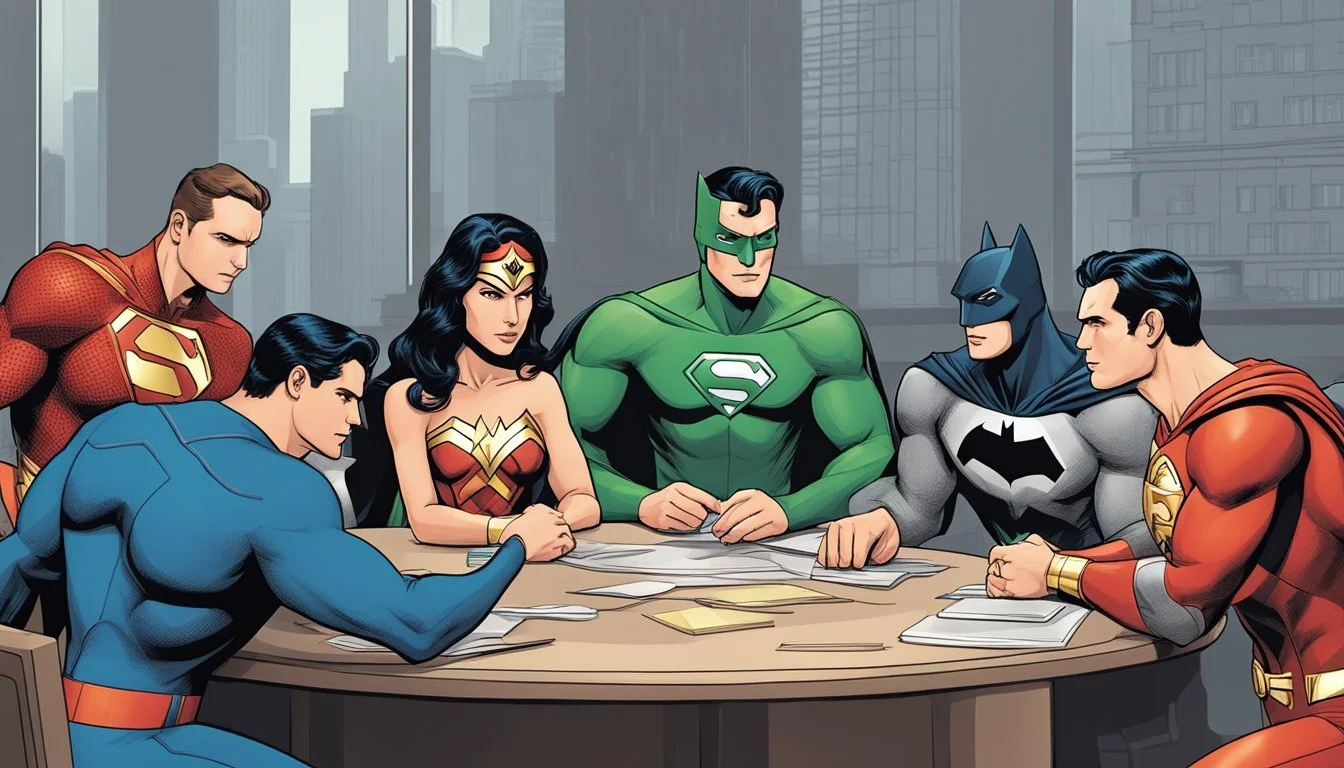Unleash Success: Discover the Power of DC Personality Types in the Workplace!
DC personality types are direct, analytical, and results-oriented individuals who thrive on challenges. These driven personalities blend the dominant traits of the D (Dominance) style with the precision-focused qualities of the C (Conscientiousness) style in the DISC personality framework. DC types are known for their straightforward communication, high energy, and perfectionist tendencies.
Characterized by their strong desire for achievement and accuracy, DC personalities often excel in leadership roles and complex problem-solving situations. They approach tasks with a laser-like focus, valuing efficiency and outcomes above all else. While their determination and analytical skills can be great assets, DC types may sometimes struggle with impatience or appear overly critical when working with others.
Understanding DC personality types can provide valuable insights into workplace dynamics and personal relationships. These individuals bring unique strengths to teams, including the ability to tackle difficult challenges head-on and push for excellence. Recognizing the traits of DC personalities can help in leveraging their talents effectively and fostering better communication within diverse groups.
Understanding DC Comics Character Archetypes
DC Comics characters embody distinct personality types that shape their motivations, actions, and relationships. These archetypes serve as the foundation for compelling storytelling and character development within the DC universe.
The Role of Personality in DC Comics
Personality traits define DC heroes and villains, driving their choices and interactions. Batman's strategic mind and brooding nature stem from his INTJ personality. Superman's ISFJ traits fuel his protective instincts and desire to help others. Wonder Woman's ENFJ qualities make her a natural leader and diplomat.
The Flash's ENFP personality contributes to his optimistic outlook and quick-thinking abilities. Green Lantern's ESTP traits align with his adventurous spirit and adaptability in cosmic conflicts.
Villains also exhibit distinct personalities. The Joker's chaotic ENTP nature contrasts sharply with Batman's methodical approach. Lex Luthor's ENTJ traits drive his ambition and strategic planning against Superman.
Hero and Villain Personality Contrasts
DC Comics often pairs heroes and villains with complementary or conflicting personality types. This dynamic creates tension and depth in their relationships.
Batman (INTJ) and the Joker (ENTP) represent order versus chaos. Their opposing approaches to problem-solving fuel their ongoing conflict.
Superman (ISFJ) and Lex Luthor (ENTJ) clash due to their differing values and methods. Superman's selflessness contrasts with Luthor's self-serving ambition.
Wonder Woman (ENFJ) often faces villains who lack her empathy and diplomatic skills, highlighting the strength of her personality type in resolving conflicts.
These personality contrasts extend to team dynamics as well. The Justice League's success stems from its diverse mix of personality types working together to overcome challenges.
DISC Model and DC Characters
The DISC model provides insights into personality traits that align with many iconic DC comic book characters. These heroes and villains exemplify different combinations of Dominance, Influence, Steadiness, and Conscientiousness in their behaviors and interactions.
Dominance Trait in DC Superheroes
DC superheroes often exhibit strong Dominance traits. Batman embodies this with his assertive leadership and decisive actions. His drive to control Gotham's criminal underworld stems from a high D personality. Superman also displays Dominance through his confident demeanor and willingness to take charge in crises.
Wonder Woman combines Dominance with Influence, showcasing both strength and charisma. Her ability to inspire others while maintaining authority reflects this D/I blend. Green Lantern's fearless nature and quick decision-making in cosmic conflicts also point to pronounced Dominance characteristics.
Influence and Communication Styles
The Flash exemplifies high Influence traits with his outgoing personality and witty banter. His optimistic outlook and ability to build rapport with allies and civilians alike reflect strong I tendencies. Aquaman blends Influence with Dominance, using charisma to lead Atlantis while commanding respect from surface dwellers.
Harley Quinn, though a villain, demonstrates extreme Influence. Her eccentric charm and persuasive abilities stem from a high I personality. Green Arrow's quips and social nature during combat also indicate significant Influence traits, balancing his more dominant aspects.
Steadiness and Emotional Stability
Martian Manhunter embodies Steadiness with his calm demeanor and patient approach to teamwork. His empathetic nature and consistent support for the Justice League align with S personality traits. Cyborg's reliability and steady performance under pressure also reflect Steadiness characteristics.
Alfred Pennyworth, Batman's butler, exemplifies a blend of Steadiness and Conscientiousness. His unwavering loyalty and meticulous attention to detail showcase these S/C traits. Lois Lane's persistent pursuit of truth in journalism, combined with her stable presence in Clark Kent's life, indicates strong Steadiness.
Conscientiousness and Detail-Orientation
Lex Luthor, despite his villainous role, displays high Conscientiousness in his methodical planning and analytical approach. His attention to detail and systematic efforts to outsmart Superman align with C personality traits. The Riddler's intricate puzzles and precisely crafted clues also point to strong Conscientiousness.
Barbara Gordon, both as Batgirl and Oracle, demonstrates Conscientiousness through her thorough research and strategic support. Her meticulous data analysis and problem-solving skills reflect C tendencies. Mr. Terrific's scientific expertise and careful consideration of facts in decision-making also exemplify Conscientiousness in the DC universe.
The Myers-Briggs Type Indicator (MBTI) and DC Characters
The MBTI provides insights into the personality traits of DC's iconic heroes and villains. This classification system reveals interesting patterns in how these characters think, feel, and interact within their fictional universe.
INTJ Heroes and Strategic Minds
Batman exemplifies the INTJ personality type. His analytical mind and strategic planning showcase the hallmarks of this rare personality. Batman's preference for working alone and his ability to see the big picture align with INTJ traits.
Lex Luthor, though a villain, also fits the INTJ mold. His intelligence and long-term scheming reflect the strategic nature of this type.
INTJs in the DC universe often play crucial roles, using their intellect to solve complex problems or orchestrate elaborate plans.
ENFJ Characters and Charismatic Leaders
Wonder Woman embodies many ENFJ traits. Her charisma, leadership skills, and desire to help others align with this personality type. ENFJs are natural leaders who inspire and motivate those around them.
Superman also displays ENFJ characteristics. His strong moral compass and ability to rally others make him a quintessential ENFJ hero.
These characters use their charm and conviction to unite teams and inspire hope in dire situations.
ISFJ Protectors in the DC Universe
Alfred Pennyworth, Batman's loyal butler, represents the ISFJ type. His dedication to serving others and maintaining traditions fits the ISFJ profile perfectly.
ISFJs in DC comics often play supporting roles, providing stability and care for the main heroes. Their reliability and attention to detail make them invaluable team members.
These characters may not always be in the spotlight, but their contributions are essential to the success of their heroic counterparts.
ISFP Peacekeepers and Aesthetes
Aquaman exhibits ISFP traits with his strong connection to nature and desire for harmony. ISFPs are often drawn to aesthetic beauty and have a deep appreciation for their surroundings.
Harley Quinn, despite her chaotic nature, shows ISFP characteristics in her spontaneity and artistic flair. ISFPs in the DC universe tend to be unpredictable and live in the moment.
These characters bring creativity and a unique perspective to their teams or individual pursuits.
ESTP Adventurers and Dynamo Heroes
The Flash embodies the ESTP personality type. His quick thinking, adaptability, and love for action align perfectly with ESTP traits. ESTPs excel in high-pressure situations and think well on their feet.
Green Lantern (Hal Jordan) also displays ESTP characteristics. His fearlessness and ability to improvise make him a classic example of this type.
ESTP characters in DC comics often provide excitement and energy to their storylines. Their bold actions and quick wit keep readers engaged.
INFP Idealists and Moral Champions
Cyborg represents INFP traits with his internal struggle and search for identity. INFPs often grapple with deep philosophical questions and strive for authenticity.
Raven from the Teen Titans also exhibits INFP characteristics. Her introspective nature and strong moral compass are typical of this personality type.
INFP characters in the DC universe often face internal conflicts. Their idealism and empathy make them relatable to readers while adding depth to storylines.
Exploring the DISC Styles of DC Characters
DC Comics features a diverse cast of characters with distinct personalities. These iconic figures exemplify various DISC styles, showcasing the range of behavioral traits within the superhero universe.
Assertive and Dominant: DC's Leaders
Batman embodies the DC (Dominance-Conscientiousness) style. He's direct, results-oriented, and highly analytical. His leadership in the Justice League stems from his assertiveness and strategic thinking. Superman, while also dominant, leans more towards the DI (Dominance-Influence) style. He combines strength with charisma, inspiring others through his actions and words.
Wonder Woman exhibits a balanced D style. She's assertive and goal-driven, yet compassionate. Her diplomatic skills complement her warrior spirit, making her an effective leader in various situations.
Green Arrow represents a unique blend of D and I styles. He's outspoken and action-oriented, but also uses his charm and wit to influence others.
Stable and Compliant: The Team Players
The Flash (Barry Allen) exemplifies the SC (Steadiness-Conscientiousness) style. He's reliable, patient, and detail-oriented. His steady nature makes him a dependable team member, while his scientific mind contributes to problem-solving.
Cyborg displays traits of the CS (Conscientiousness-Steadiness) style. He's methodical, analytical, and values stability. His technical expertise and calm demeanor make him an essential support for the team.
Martian Manhunter leans towards the S style. He's a supportive team player, often working behind the scenes. His empathetic nature and desire for harmony contribute to team cohesion.
Influential Figures: Charisma in Action
Green Lantern (Hal Jordan) embodies the I (Influence) style. He's outgoing, optimistic, and persuasive. His ability to inspire others and think creatively makes him a natural leader in cosmic conflicts.
Aquaman combines I and D styles. As king of Atlantis, he uses his charisma to lead and his assertiveness to command respect. His diplomatic skills are crucial in bridging the gap between land and sea.
Shazam (Billy Batson) represents a youthful I style. His enthusiasm and social nature make him relatable, while his alter ego's power adds a layer of confidence to his influential personality.
Conscientious and Accurate: The Analytical Minds
Lex Luthor, despite being a villain, exemplifies the C (Conscientiousness) style. He's detail-oriented, analytical, and strives for perfection. His methodical approach and focus on accuracy drive his schemes and inventions.
Barbara Gordon (Oracle) displays strong C traits. Her analytical skills and attention to detail make her an invaluable information resource. She excels in planning and problem-solving, supporting the heroes from behind the scenes.
Mr. Terrific combines C and D styles. His "third smartest person in the world" title highlights his analytical nature, while his leadership in the Justice Society showcases his assertive side.
Personality Traits and Character Narratives
DC superheroes exhibit diverse personality traits that shape their narratives and relationships. These characteristics influence their motivations, alliances, and reactions to challenges.
Motivations and Goals of DC Superheroes
Batman's drive stems from a desire to prevent others from experiencing the trauma of losing loved ones. His goal is to rid Gotham City of crime and corruption.
Superman aims to protect Earth and uphold justice, motivated by his adoptive parents' values and his Kryptonian heritage. He strives to be a symbol of hope for humanity.
The Flash is driven by a sense of responsibility to use his superspeed for good. His goal is to keep Central City safe while balancing his heroic duties with his personal life.
Interpersonal Relationships and Alliances
Batman forms strategic alliances but often struggles with trust issues. His closest relationships include Alfred Pennyworth and select members of the Bat-family.
Superman's friendly nature allows him to form strong bonds with fellow heroes. His key relationships include Lois Lane, Jimmy Olsen, and the Justice League members.
The Flash values teamwork and camaraderie. He maintains close friendships with other speedsters and Justice League colleagues.
Individual Fears and Stressors
Batman's fear of failure and losing more loved ones drives his obsessive crime-fighting behavior. The potential loss of control is a significant stressor for him.
Superman grapples with the fear of not living up to expectations or accidentally harming others due to his immense power. Kryptonite and threats to his loved ones are major stressors.
The Flash fears being too slow to save everyone. Time paradoxes and the potential consequences of altering the timeline cause him considerable stress.
Impact of Personality Types on Storytelling
Personality types form the bedrock of compelling narratives, shaping how characters interact and driving plot progression. They influence decision-making, conflict resolution, and relationship dynamics within stories.
Shaping Plots Through Character Personalities
Character personalities serve as catalysts for plot development. An introverted hero might approach challenges differently than an extroverted one, leading to unique story arcs. In DC Comics, Batman's analytical INTJ personality type informs his detective work and strategic planning.
Personality traits also affect character growth. A risk-averse character may face situations that push them out of their comfort zone, creating engaging character development arcs. Superman's ENFJ personality type drives his desire to protect and inspire others, often forming the core of his storylines.
Writers use personality types to create consistent character behaviors and reactions. This consistency helps readers connect with characters and understand their motivations throughout the narrative.
Conflict and Resolution Driven by Dispositions
Personality clashes fuel conflict in storytelling. Opposing personality types can create tension between characters, driving the plot forward. In DC Comics, the stark contrast between the Joker's chaotic ENTP personality and Batman's structured INTJ type generates compelling conflicts.
Character dispositions also influence problem-solving approaches. A methodical character might tackle issues differently than an impulsive one, leading to varied plot resolutions. The Flash's ESFP personality type often results in quick, instinctive solutions, while Cyborg's ISTJ traits lead to more calculated approaches.
Personality types shape communication styles between characters, affecting dialogue and interpersonal dynamics. This interplay of personalities enriches storytelling by creating realistic and nuanced character interactions.
Personality Assessments in Real Life Applications
Personality assessments offer valuable insights for organizations and individuals in various real-world scenarios. These tools help improve communication, enhance team dynamics, and optimize leadership strategies.
Applying DISC to Understand Real-world Leadership
The DISC assessment provides a framework for understanding leadership styles and behaviors. It categorizes individuals into four main personality types: Dominance, Influence, Steadiness, and Conscientiousness.
Leaders who understand their DISC profile can adapt their communication style to better connect with team members. For example, a high-D leader may learn to slow down and provide more detail for high-C team members.
DISC insights help managers assign tasks based on individual strengths. A high-I employee might excel in client-facing roles, while a high-S team member could thrive in supportive, behind-the-scenes positions.
Organizations use DISC to improve team dynamics and resolve conflicts. By recognizing different personality types, colleagues can appreciate diverse perspectives and work together more effectively.
Using MBTI to Assess Team Dynamics
The Myers-Briggs Type Indicator (MBTI) is widely used in corporate settings to enhance team performance and collaboration. This assessment categorizes individuals into 16 personality types based on four dichotomies.
MBTI results help team members understand their own work preferences and those of their colleagues. This awareness can lead to improved communication and reduced misunderstandings.
Managers use MBTI insights to create balanced teams. For example, pairing detail-oriented "Sensing" types with big-picture "Intuitive" thinkers can lead to more comprehensive problem-solving.
The MBTI framework assists in conflict resolution by highlighting different approaches to decision-making and information processing. Teams can leverage these differences to generate innovative solutions and foster a more inclusive work environment.




